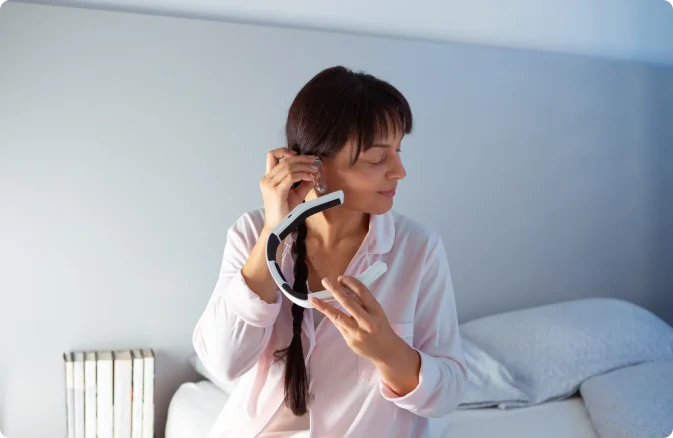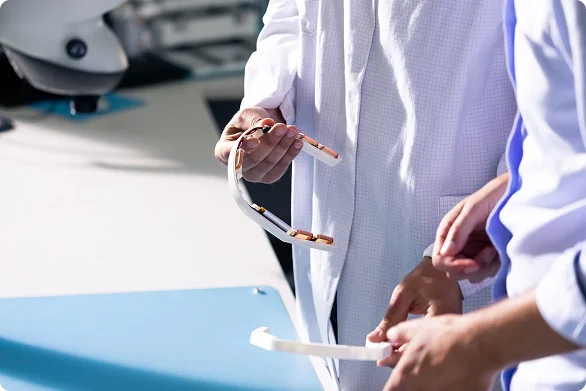
How to use your
PEMF device
Welcome to our PEMF device support page.
Here, you’ll find expert guidance to optimize your experience with PEMF therapy, ensuring you unlock its full potential for your overall well-being.

Welcome to our PEMF device support page.
Here, you’ll find expert guidance to optimize your experience with PEMF therapy, ensuring you unlock its full potential for your overall well-being.
Compare Features and Benefits to Find the Right PEMF Device for You
Start by downloading our Neorhythm App to your phone.
Wish to turn your NeoRhythm’s lights, vibration or Bluetooth off?

Tap it twice and start the last program you used. Changing programmes is not possible by tapping. To change to another program the phone must be present.

A revolutionary solution for total wellness. Designed for use for the entire body, it targets discomfort by simply placing it on the affected area or around the neck for VNS (Vagus Nerve Stimulation). With limitless options, it offers a transformative approach to improving sleep, focus, relaxation and overall well-being.

Designed to be placed under or on the body like a comforting blanket, our PEMF Pad is here for you to relieve pain discomfort, induce relaxation and improve sleep.

The perfect solution for wellness on the go, whether at home, in the car or at the office. Designed to easily attach to your seat for convenience, this tubular PEMF device is here for you to relieve pain, induce relaxation, improve concentration, and more.
PEMF devices affect the body on a cellular level, allowing stimulation of any part of the body and acting as a soothing and restorative modality.
NeoRhythm products are designed to be applied to a specific part of the body. For a better fit on the extremities, we recommend using the NeoWrap, Support Wrap or Headband.

Get Support and Answers to Your Questions
Please write to us by clicking HERE.
*On average, we respond within 12 hours during working days, but not more than 24 hours. All inquiries sent to us during weekends and holidays will be answered on the following Monday or the next working day.
Please book a video call HERE.
Once processed, standard shipping generally takes between 3 to 5 business days. However, please keep in mind that unexpected factors such as weather conditions or customs clearance may occasionally affect delivery times. If you require more detailed delivery estimates, don't hesitate to reach out to ourack guarantee. Contact our Support Team.
We are confident that you will love your new PEMF device. Omnipemf offers a 60-day money-back guarantee starting from the day you receive your device. If you are not satisfied with the results, simply return your NeoRhythm to us for a full refund. Visit our Returns and Refunds page for more information.
NeoRhythm is generally safe for use. However, people with certain medical conditions SHOULD NOT use the device:
We suggest consulting your healthcare professional before using NeoRhythm if you have any medical condition or any concerns regarding the use of such technology.
Multiple payment methods are at your disposal. You can make payments using a variety of methods, including different credit cards (Visa / MasterCard), Paypal, and also installment payments with Splitit.
NeoRhythm has not been evaluated by the FDA and is considered a general wellness device. These products do not claim to diagnose, treat, cure, or prevent any medical condition. Always consult your medical provider regarding any medical concerns. MDCN Tech Ltd. is a legal entity registered in the EU, under the local jurisdiction of the territory. For further information, please contact us directly or contact the regulatory authorities that have jurisdiction over your area.
We apologize for the inconvenience. If your form of payment or credit card isn’t getting recognized by our payment process we advise you to check out using PayPal or contact us for more information.
If you have any questions, suggestions, or other comments, feel free to contact our Support Team. We're here to help!
Omnipemf does not impose any additional costs after the NeoRhythm has been ordered. Any import duties and taxes are the sole responsibility of the buyer and a subject to local laws, and Omnipemf does not control nor cover these expenses. In the US, goods under $800 may be imported free of duties, whereas in the EU the price already includes VAT.
We offer free shipping to the United States, United Kingdom, Europe, and 96 other countries. If you have any questions regarding delivery, do not hesitate to contact us. NeoRhythm currently cannot be shipped to Mexico, Brazil, Chile, India, Vietnam and Russia due to local import laws.
Good News for Our US Clients!
All of our PEMF devices are HSA/FSA eligible, meaning you can use your health savings or flexible spending account to purchase them. This is a great opportunity to invest in your health using pre-tax dollars.
If you’re interested in taking advantage of this benefit, simply contact our support team at foryou@omnipemf.com, and we’ll send you all the necessary documentation to ensure a smooth process.